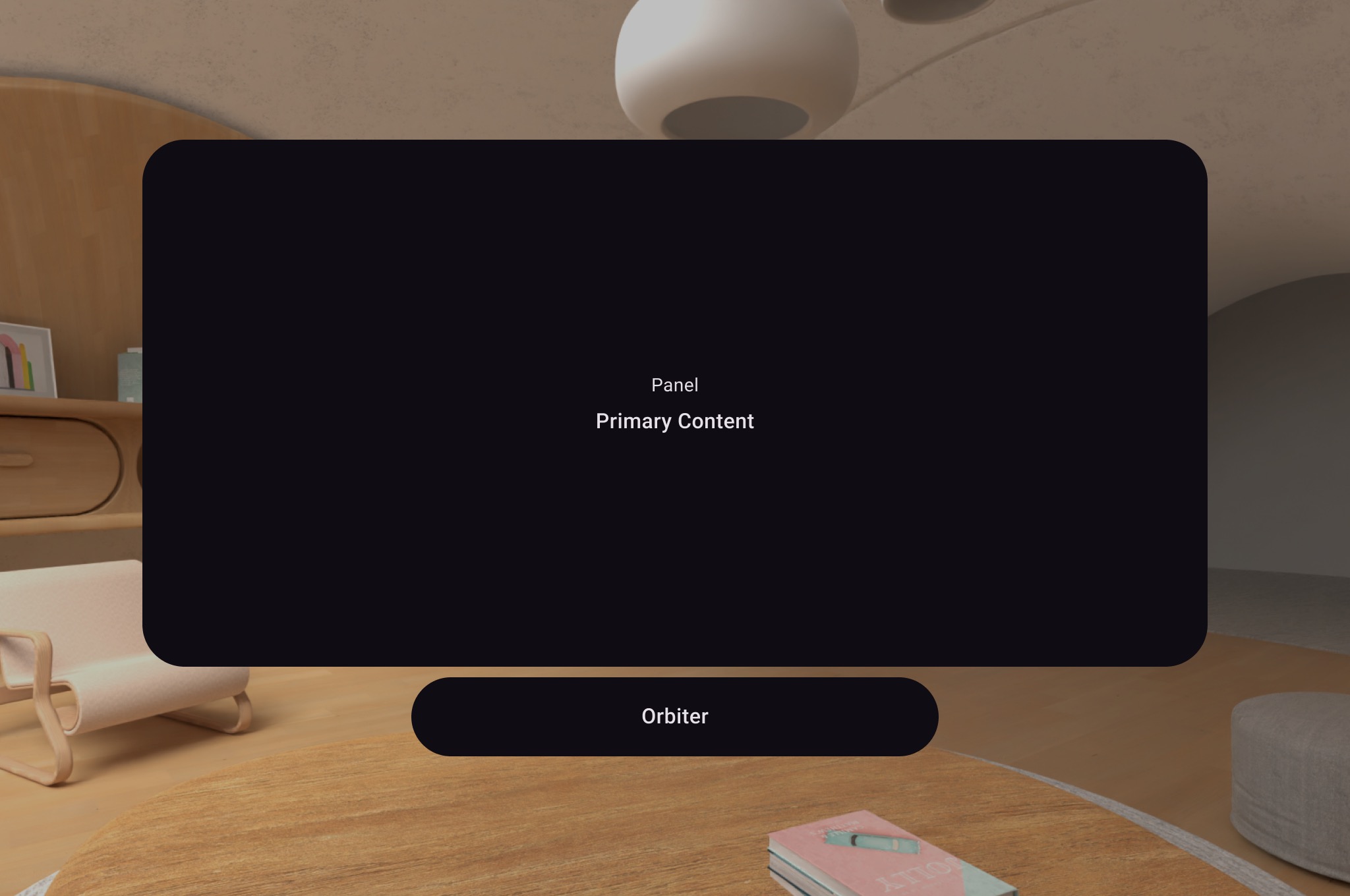تتيح لك حزمة تطوير البرامج (SDK) لمنصة Jetpack XR إنشاء تجارب غامرة في الواقع الممتد باستخدام أدوات حديثة، مثل Kotlin وCompose، بالإضافة إلى أدوات الجيل السابق، مثل Java وViews. يمكنك تحديد موضع عناصر واجهة المستخدم وتحميل وعرض نماذج ثلاثية الأبعاد وفهم العالم الحقيقي دلاليًا.
إذا كان لديك تطبيق على الأجهزة الجوّالة أو شاشة كبيرة على Android، يوسّع Jetpack XR SDK نطاق تطبيقك إلى بُعد جديد من خلال تحويل التصاميم الحالية إلى تصاميم مكانية وتحسين تجاربك باستخدام نماذج ثلاثية الأبعاد وبيئات غامرة. يمكنك الاطّلاع على إرشادات الجودة للحصول على اقتراحاتنا بشأن تحويل تطبيق Android الحالي إلى تطبيق مكاني.
تتألف حزمة تطوير البرامج (SDK) من Jetpack XR من المكتبات التالية. وتوفّر هذه الأدوات معًا مجموعة شاملة لإنشاء تجارب مكانية غنية ومتنوعة، وهي مصمَّمة للعمل معًا بسلاسة.
- Jetpack Compose للواقع الممتد (XR): يمكنك إنشاء تصاميم تعريفية لواجهات المستخدم المكانية التي تستفيد من إمكانات Android XR المكانية.
- Material Design للواقع الممتد: يمكنك إنشاء تطبيقات باستخدام مكونات وتنسيقات Material تتكيّف مع تجربة الواقع الممتد.
- Jetpack SceneCore: يمكنك إنشاء مخطط المشهد في Android XR وتعديله باستخدام محتوى ثلاثي الأبعاد.
- ARCore for Jetpack XR: يمكنك دمج المحتوى الرقمي في العالم الحقيقي باستخدام إمكانات الإدراك.
Jetpack Compose لتجربة الواقع المختلط
باستخدام Jetpack Compose for XR، يمكنك استخدام مفاهيم Compose المألوفة، مثل الصفوف والأعمدة، لإنشاء تصاميم واجهة مستخدم مكانية في تجارب الواقع الممتد، سواء كنت تنقل تطبيقًا ثنائي الأبعاد حاليًا إلى تجارب الواقع الممتد أو تنشئ تطبيقًا جديدًا من البداية.
توفّر هذه المكتبة عناصر واجهة مستخدم قابلة للإنشاء في المساحات الفرعية، مثل اللوحات المكانية والعناصر الدوّارة، ما يتيح لك وضع واجهة المستخدم الحالية المستندة إلى Compose أو Views ثنائية الأبعاد في تصميم مكاني.
راجِع تطوير واجهة مستخدم باستخدام Jetpack Compose لمنصة XR للحصول على إرشادات مفصّلة.

تقدّم Compose for XR العنصر القابل للإنشاء Volume الخاص بالمساحة الفرعية، والذي يتيح لك وضع عناصر SceneCore، مثل النماذج الثلاثية الأبعاد، بالنسبة إلى واجهة المستخدم.
تعرَّف على كيفية تحويل تطبيق Android الحالي إلى تطبيق مكاني أو اطّلِع على مرجع واجهة برمجة التطبيقات للحصول على معلومات أكثر تفصيلاً.
Material Design لتجربة الواقع المُمتد
توفّر Material Design مكوّنات وتخطيطات تتكيّف مع تجارب الواقع الممتد. على سبيل المثال،
إذا كنت تستخدم التنسيقات التكيّفية وأردت التحديث إلى أحدث إصدار
أولي من التبعية باستخدام برنامج تضمين EnableXrComponentOverrides،
سيتم وضع كل جزء داخل SpatialPanel وسيتم وضع شريط التنقّل في Orbiter. مزيد من المعلومات حول تنفيذ
Material Design for XR
Jetpack SceneCore
تتيح لك مكتبة Jetpack SceneCore وضع محتوى ثلاثي الأبعاد وترتيبه، ويتم تحديد هذا المحتوى من خلال الكيانات، بالنسبة إلى بعضها البعض وإلى البيئة المحيطة بك. باستخدام SceneCore، يمكنك:
- ضبط البيئات المكانية
- إنشاء مثيلات
PanelEntity - وضع نماذج ثلاثية الأبعاد وتحريكها
- تحديد مصادر الصوت المكاني
- إضافة "مكوّنات" إلى الكيانات لجعلها قابلة للنقل وتغيير الحجم، ويمكن تثبيتها في العالم الحقيقي
توفّر مكتبة Jetpack SceneCore أيضًا إمكانية تحويل التطبيقات التي تم إنشاؤها باستخدام "طرق العرض" إلى تطبيقات مكانية. يمكنك الاطّلاع على دليلنا حول كيفية العمل باستخدام طرق العرض لمزيد من التفاصيل.
يمكنك الاطّلاع على مرجع واجهة برمجة التطبيقات للحصول على مزيد من المعلومات التفصيلية.
ARCore for Jetpack XR
استنادًا إلى مكتبة ARCore الحالية، توفّر مكتبة ARCore for Jetpack XR إمكانات لدمج المحتوى الرقمي مع العالم الحقيقي. تتضمّن هذه المكتبة تتبُّع الحركة، وعناصر التثبيت الدائمة، واختبارات النتائج، وتحديد مستوى الارتفاع مع التصنيف الدلالي (مثل الأرضيات والجدران وأسطح الطاولات). تستفيد هذه المكتبة من حزمة الإدراك الأساسية المستندة إلى OpenXR، ما يضمن التوافق مع مجموعة كبيرة من الأجهزة ويساعد في ضمان توافق التطبيقات مع التحديثات المستقبلية.
يمكنك الاطّلاع على استخدام ARCore في Jetpack XR للحصول على مزيد من المعلومات التفصيلية.
ملاحظة حول "معاينة المطوّر"
يُرجى العِلم أنّ هذا الإصدار هو جزء من معاينة المطوّر، وأنّ واجهات برمجة التطبيقات هذه لا تزال قيد التطوير. راجِع ملاحظات الإصدار للاطّلاع على المشاكل المعروفة:
- ملاحظات إصدار Jetpack Compose for XR
- ملاحظات إصدار ARCore لـ Jetpack XR
- ملاحظات إصدار Jetpack SceneCore
- ملاحظات إصدار Jetpack for SceneCore Runtime
إذا واجهت مشكلة غير مُدرَجة في تلك القائمة، يُرجى الإبلاغ عن خطأ أو إرسال ملاحظات.
OpenXR™ وشعار OpenXR هما علامتان تجاريتان مملوكتان لشركة The Khronos Group Inc. ومسجّلتان كعلامة تجارية في الصين والاتحاد الأوروبي واليابان والمملكة المتحدة.

